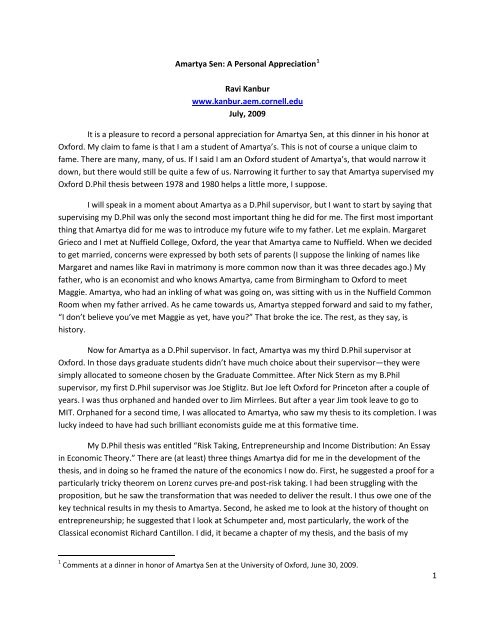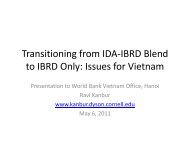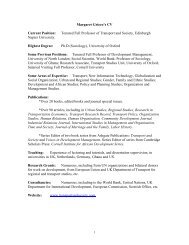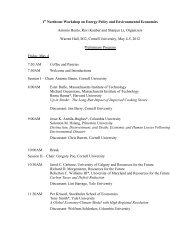Amartya Sen: A Personal Appreciation - Ravi Kanbur
Amartya Sen: A Personal Appreciation - Ravi Kanbur
Amartya Sen: A Personal Appreciation - Ravi Kanbur
You also want an ePaper? Increase the reach of your titles
YUMPU automatically turns print PDFs into web optimized ePapers that Google loves.
<strong>Amartya</strong> <strong>Sen</strong>: A <strong>Personal</strong> <strong>Appreciation</strong> 1<br />
<strong>Ravi</strong> <strong>Kanbur</strong><br />
www.kanbur.aem.cornell.edu<br />
July, 2009<br />
It is a pleasure to record a personal appreciation for <strong>Amartya</strong> <strong>Sen</strong>, at this dinner in his honor at<br />
Oxford. My claim to fame is that I am a student of <strong>Amartya</strong>’s. This is not of course a unique claim to<br />
fame. There are many, many, of us. If I said I am an Oxford student of <strong>Amartya</strong>’s, that would narrow it<br />
down, but there would still be quite a few of us. Narrowing it further to say that <strong>Amartya</strong> supervised my<br />
Oxford D.Phil thesis between 1978 and 1980 helps a little more, I suppose.<br />
I will speak in a moment about <strong>Amartya</strong> as a D.Phil supervisor, but I want to start by saying that<br />
supervising my D.Phil was only the second most important thing he did for me. The first most important<br />
thing that <strong>Amartya</strong> did for me was to introduce my future wife to my father. Let me explain. Margaret<br />
Grieco and I met at Nuffield College, Oxford, the year that <strong>Amartya</strong> came to Nuffield. When we decided<br />
to get married, concerns were expressed by both sets of parents (I suppose the linking of names like<br />
Margaret and names like <strong>Ravi</strong> in matrimony is more common now than it was three decades ago.) My<br />
father, who is an economist and who knows <strong>Amartya</strong>, came from Birmingham to Oxford to meet<br />
Maggie. <strong>Amartya</strong>, who had an inkling of what was going on, was sitting with us in the Nuffield Common<br />
Room when my father arrived. As he came towards us, <strong>Amartya</strong> stepped forward and said to my father,<br />
“I don’t believe you’ve met Maggie as yet, have you” That broke the ice. The rest, as they say, is<br />
history.<br />
Now for <strong>Amartya</strong> as a D.Phil supervisor. In fact, <strong>Amartya</strong> was my third D.Phil supervisor at<br />
Oxford. In those days graduate students didn’t have much choice about their supervisor—they were<br />
simply allocated to someone chosen by the Graduate Committee. After Nick Stern as my B.Phil<br />
supervisor, my first D.Phil supervisor was Joe Stiglitz. But Joe left Oxford for Princeton after a couple of<br />
years. I was thus orphaned and handed over to Jim Mirrlees. But after a year Jim took leave to go to<br />
MIT. Orphaned for a second time, I was allocated to <strong>Amartya</strong>, who saw my thesis to its completion. I was<br />
lucky indeed to have had such brilliant economists guide me at this formative time.<br />
My D.Phil thesis was entitled “Risk Taking, Entrepreneurship and Income Distribution: An Essay<br />
in Economic Theory.” There are (at least) three things <strong>Amartya</strong> did for me in the development of the<br />
thesis, and in doing so he framed the nature of the economics I now do. First, he suggested a proof for a<br />
particularly tricky theorem on Lorenz curves pre‐and post‐risk taking. I had been struggling with the<br />
proposition, but he saw the transformation that was needed to deliver the result. I thus owe one of the<br />
key technical results in my thesis to <strong>Amartya</strong>. Second, he asked me to look at the history of thought on<br />
entrepreneurship; he suggested that I look at Schumpeter and, most particularly, the work of the<br />
Classical economist Richard Cantillon. I did, it became a chapter of my thesis, and the basis of my<br />
1 Comments at a dinner in honor of <strong>Amartya</strong> <strong>Sen</strong> at the University of Oxford, June 30, 2009.<br />
1
subsequent interest in the history of economic thought as an underpinning to current debates. Third,<br />
since in my model individuals were ex ante identical, and inequality was only ex post after the<br />
consequences of risk taking had been revealed, <strong>Sen</strong> posed the question: In what precise sense is there<br />
inequality in this society Thirty years on, I now recognize the question to have been a natural one for<br />
him to have posed at that time, coming as it did in the middle of his highly fruitful engagement with, and<br />
critique of, Utilitarianism. For me, it marked the start of my own engagement with the interactions<br />
between economics and philosophy.<br />
Thus my thesis already bore the hallmarks of <strong>Sen</strong> the technical economist, <strong>Sen</strong> the historian of<br />
economic thought, and <strong>Sen</strong> the philosopher. But then when I began work on development economics,<br />
everywhere I turned, every topic I worked on, I saw the influence of <strong>Sen</strong>: growth theory, measurement<br />
of inequality and poverty, gender and intrahousehold distribution, human development, and on and on.<br />
On poverty measurement, <strong>Sen</strong> set down the basic Axioms that framed the literature for the next three<br />
decades. Even when some of the axioms are questioned and relaxed (sometimes by <strong>Sen</strong> himself), it is<br />
these “<strong>Sen</strong> Axioms” that structure our substantive and technical discourse. More recently, as I have<br />
turned to questions of history and development, and as I have engaged in public discourse and debate<br />
on development, <strong>Sen</strong>’s large footprints are again leading the way.<br />
In human development, <strong>Sen</strong> worked with another great economist, the late Mahbub ul Haq, in<br />
the formulation of the Human Development Index (HDI). I recall a story that <strong>Amartya</strong> tells about that<br />
development, when he was offering a critique of various technical aspects of the HDI to Mahbub.<br />
Paraphrasing <strong>Amartya</strong>’s retelling, Mahbub said something like—I understand the technical issues (which<br />
he undoubtedly did—Mahbub was no mean technical economist himself), but my objective is not so<br />
much to have the perfect index but rather to have something that can change the terms of the political<br />
debate by putting education and health on an equal footing with income. <strong>Amartya</strong> concludes the story<br />
by noting the obvious success of Mahbub’s project, a project in which <strong>Amartya</strong> has of course played a<br />
central role.<br />
When <strong>Amartya</strong> won the Nobel Prize in 1998, there was much confusion in the popular press<br />
about what he won it for. Some said it was for development economics. Others said it was for his<br />
fundamental work on famines. Yet others thought it was the Peace prize given for his unceasing support<br />
of human rights causes. In fact, he won it for welfare economics. The breadth of <strong>Amartya</strong>’s interest and<br />
contributions is quite extraordinary. When my friend and colleague, and a fellow <strong>Sen</strong> student, Kaushik<br />
Basu and I began planning the Festschrift for <strong>Amartya</strong>’s 75 th birthday, we were not surprised when we<br />
ended up with almost 60 papers in two volumes. The two volumes, “Ethics, Welfare and Measurement”<br />
and “Society, Institutions and Development,” together make up the Festschrift, Arguments for a Better<br />
World: Essays in Honor of <strong>Amartya</strong> <strong>Sen</strong> (published by Oxford University Press, 2008).<br />
The different sections of the Festschrift volumes give an idea of the range of <strong>Sen</strong>’s contributions:<br />
“Ethics, Normative Economics and Welfare,” “Agency, Aggregation and Social Choice,” “Poverty,<br />
Capabilities and Measurement,” “Identity, Collective Action and Public Economics,” “Human<br />
Development and Capabilities,” Gender and Household,” “Growth, Poverty and Policy,” and “Society,<br />
2
Politics and History.” The papers include Joe Stiglitz on Inequality, Bob Solow on Trade and Environment,<br />
Tim Scanlon on Rights, Jonathan Glover on Identity, Bina Agarwal on Gender, Sunil Khilnani on<br />
Democracy in India, Montek Ahluwalia on Indian economic policy, Jane Humphries on mortality of<br />
women in Victorian England, Ayesha Jalal on Iqbal’s philosophy, and on it goes. What is amazing is that<br />
all of these authors saw themselves as engaging with some aspect of <strong>Sen</strong>’s writing!<br />
And <strong>Amartya</strong>’s own recent papers continue to be amazing. My favorite is “Sraffa, Wittgenstein<br />
and Gramsci,” published in the Journal of Economic Literature (Vol, 91, No,. 4, 2003, pp 1240‐1255). This<br />
is a quite extraordinary exploration of Sraffa’s influence on the movement of Wittgenstein’s thinking<br />
from the “early Wittgenstein” of Tractatus Logico‐Philosophicus to the “later Wittgenstein” of<br />
Philosophical Investigations, linked in turn to the influence on Sraffa of activist political circles in Italy<br />
around the journal L’Ordine Nuovo, to which Gramsci also belonged. In a subtle and deft argument, <strong>Sen</strong><br />
traces the influence, through Sraffa, of Gramsci’s Prison Notebooks and their emphasis on “ordinary<br />
language philosophy,” on the shift from language seen in isolation in the Tractatus to language in the<br />
context of conventions in Philosophical Investigations. <strong>Sen</strong> refers to the famous anecdote, whereby<br />
Sraffa is meant to have begun Wittgenstein’s shift from the picture theory of language to a richer<br />
account of how social conventions contribute to meaning: “Sraffa responded to Wittgenstein’s claim by<br />
brushing his chin with his fingertips, which is apparently readily understood as a Neapolitan gesture of<br />
skepticism, and then asked, “What is the logical form of this” (p 1242). The paper shows Sraffa to have<br />
been pivotal in 20 th century philosophy, but it takes <strong>Sen</strong> the economist, the historian and the<br />
philosopher to show us in what way.<br />
Ultimately, it is <strong>Sen</strong>’s scope that is breathtaking. Excellence in each dimension, for sure, but it is<br />
the number of dimensions that stuns. One is reminded of Keynes’s characterization of the master<br />
economist. In a famous passage he writes:<br />
“…the master‐economist must possess a rare combination of gifts. He must reach a high<br />
standard in several different directions and must combine talents not often found together. He must be<br />
mathematician, historian, statesman, philosopher—in some degree. He must understand symbols and<br />
speak in words. He must contemplate the particular in terms of the general, and touch abstract and<br />
concrete in the same flight of thought. He must study the present in the light of the past for the<br />
purposes of the future. No part of man's nature or his institutions must lie entirely outside his regard. He<br />
must be purposeful and disinterested in a simultaneous mood; as aloof and incorruptible as an artist,<br />
yet sometimes as near the earth as a politician.”<br />
Now, Keynes developed this standard to assess Marshall (“Alfred Marshall: 1842‐1924” (1924). In The<br />
Collected Writings of John Maynard Keynes, Volume X, Essays in Biography, 1972, Chapter 14, p 173).<br />
Keynes, however, goes on to say that “Much, but not all, of this ideal many‐sidedness Marshall<br />
possessed.” In other words, according to Keynes, Marshall just missed the bar! One can’t help thinking<br />
that the person Keynes was describing was‐‐‐‐‐Keynes himself.<br />
3
Well, we may debate whether Marshall satisfies the Keynesian criteria or not. We may even<br />
debate whether Keynes satisfies the criteria. But on whether <strong>Sen</strong> satisfies the criteria, there can be no<br />
debate. He is indeed the master‐economist of our time.<br />
Ladies and gentlemen, please raise your glasses to my teacher, <strong>Amartya</strong> <strong>Sen</strong>.<br />
4





